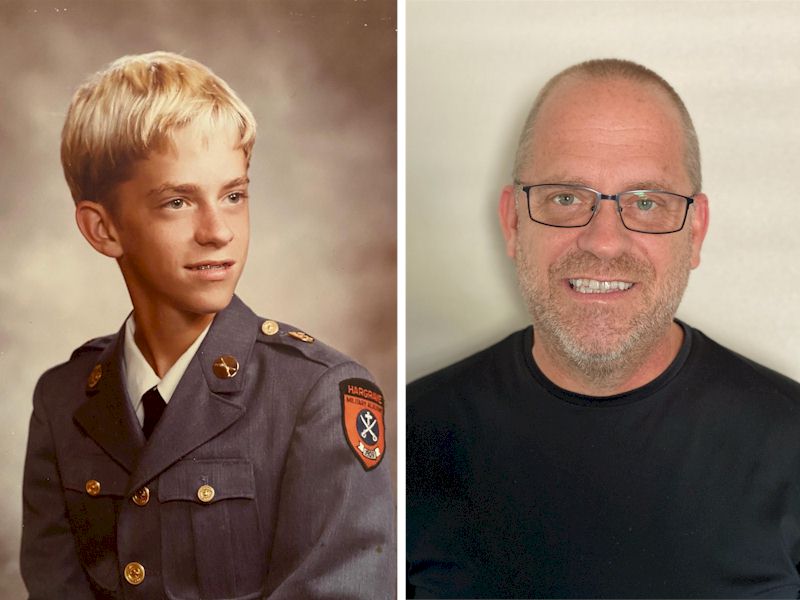Dr. Robert Elkins’ family arrived in Danville almost by accident. From Florida originally, the family was on an airplane trip to New York when they found they needed to refuel. A friend traveling with them suggested a stop in Danville, where an old medical school chum was currently operating a successful orthopedic practice. Dr. and Mrs. Elkins met with Dr. Ogden, who showed them around Danville. They instantly fell in love with the city and particularly with Millionaire’s Row in the Old West End. Soon after, the Elkins purchased the Lanier-Wyllie house at 770 Main Street and relocated the family to Danville from Florida.
Life in the house is fondly remembered today by Mrs. Elkins’ son, James Vanden Bosch – pictured above during his time at nearby Hargrave Military Academy and again today from his home in Mississippi. “On first seeing the house,” he said, “I was awestruck by the size and the appearance of the building. I felt like we were coming onto the set of Gone With The Wind.” Young James found the house full of charm and felt he was taking a step back in time upon moving into it. He’d only seen homes like this in pictures. The home boasted 15 large rooms, all with high ceilings, wood floors, and ornate architectural details. In comparison to the homes he had lived in in Florida, constructed of concrete and built to withstand hurricanes, this was like a palace. He compared its significance to historic homes like Monticello.
James, even as a boy of fourteen, was intrigued with the history of the house, particularly with the different ways in which the house was used in previous eras. A side entrance, for instance, provided access to servants and domestic help. Benches lined the walls, providing a waiting area for the previous doctor’s patients of color to wait during the days of segregation. A hitching post outside, near the servants’ entranced provided a place for early visitors to hitch their horses (and receive what necessary care they required from livery and stable hands) prior to the proliferation of cars. The evolution of the house intrigued him and he was delighted when former residents and their descendants would stop by to reminisce about the home’s former days.
With the Elkins’ arrival came a flurry of remodeling and restoration work. James remembers the early days of his residence when he was impressed by so many of the home’s decorative appointments, such as the dark wood floors that creaked with every step and the hand-carved staircase banister, as well as the ornate chandelier that hung in the foyer–all of which were dusty and covered in cobwebs upon their arrival. Plaster had fallen away from the walls in some places, revealing the lathe. The upstairs contained two residential apartments. Dr. and Mrs. Elkins made plans right away to convert the first floor into an orthopedic clinic, their intention being to “enhance the structure of its original statehood while bringing a modern look in developing the clinic”.
A year later, when the workmen left, the house had been carefully restored inasmuch as it was possible to do while still running a state-of-the-art medical facility. It was during the restoration that a number of items belonging to the former residents were discovered. James learned of Dr. Newman by the photographs his family left behind. Newspaper articles were also found, in which Dr. Newman was described as a compassionate and giving man who had established himself as a pillar of Danville society and of the medical community. Some items related to his medical practice were also found, such as glass syringes. These were collected and put on display in Dr. Elkins’ office, both as artifacts of a previous era in medicine, but also in honor of Dr. Newman who had been so important to the community and to the history of the house.
Prior to living in the house, James had not believed in ghosts or the paranormal. Living in the Lanier-Wyllie house convinced him otherwise. Most of the occurrences, he says, happened near the back staircase, where, at “all hours of the day and night, footsteps could be heard climbing or descending the stairs.” Having heard the noise, he would step out into the hallway expecting someone to be there, and yet no one appeared. In the physical therapy clinic downstairs, shadow-like apparitions would appear and cold drafts would blow through the rooms, even on the hottest of summer days. The family, always careful about locking the doors, would awake in the morning to find the back door standing wide open. Sometimes in the middle of the day, as well, the door would open for no apparent reason and by no one who would admit to doing so. On several occasions, James heard the sound of whispering voices. He was never afraid, though. Eerie and strange as the occurrences were, the family grew to accept them as part of living in a house that was shared with the ghosts of those who had lived there before.
The Elkins family left the home in 1987, but the experience has stayed with Mr. Vanden Bosch for the rest of his life. “The Main Street house was more than a house,” he told us. “I’d like to think that it became a major part of my life, and I should hope that a little part of me remains from within it.”
Many thanks to James for writing about his first stint in Danville. He lived with us again briefly just a few years ago.
